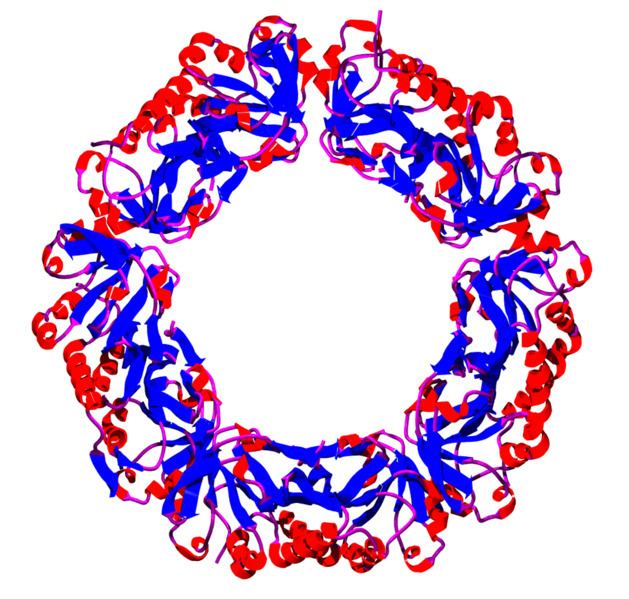Symbol AhpC-TSA Pfam clan CL0172 SCOP 1prx | Pfam PF00578 InterPro IPR000866 SUPERFAMILY 1prx | |
 | ||
Peroxiredoxins (Prxs, EC 1.11.1.15; HGNC root symbol PRDX) are a ubiquitous family of antioxidant enzymes that also control cytokine-induced peroxide levels and thereby mediate signal transduction in mammalian cells. The family members in humans are PRDX1, PRDX2, PRDX3, PRDX4, PRDX5, and PRDX6. The physiological importance of peroxiredoxins is illustrated by their relative abundance (one of the most abundant proteins in erythrocytes after hemoglobin is peroxiredoxin 2).
Contents
Classification
Prxs were historically divided into three (mechanistic) classes:
The designation of “1-Cys” and “2-Cys” Prxs was introduced in 1994 as it was noticed that, among the 22 Prx sequences known at the time, only one Cys residue was absolutely conserved; this is the residue now recognized as the (required) peroxidatic cysteine, CP. The second, semi-conserved cysteine noted at the time is the resolving cysteine, CR, which forms an intersubunit disulfide bond with CP in the widespread and abundant Prxs sometimes referred to as the “typical 2-Cys Prxs”. Ultimately it was realized that the CR can reside in multiple positions in various Prx family members, leading to the addition of the “atypical 2-Cys Prx” category (Prxs for which a CR is present, but not in the "typical," originally identified position).
With the large amount of information currently available regarding Prx structures and sequences, family members are now recognized to fall into six classes or subgroups, designated as Prx1 (essentially synonymous with “typical 2-Cys”), Prx5, Prx6, PrxQ, Tpx and AhpE groups. It is now recognized that the existence and location of CR across all 6 groups is heterogeneous. Thus, even though the “1-Cys Prx” designation was originally associated with the Prx6 group based on the lack of a CR in human PrxVI, and many Prx6 group members appear not to have a CR, there are “1-Cys” members in all of the subgroups. Moreover, the CR can be located in 5 (known) locations in the structure, yielding either an intersubunit or intrasubunit disulfide bond in the oxidized protein (depending on CR location). To assist with identification of new members and the subgroup to which they belong, a searchable database (the PeroxiRedoxin classification indEX) including Prx sequences identified from GenBank (January 2008 through October 2011) was generated by bioinformatics analysis and is publicly available.
Catalytic Cycle of Peroxiredoxins
These enzymes share the same basic catalytic mechanism, in which a redox-active cysteine (the peroxidatic cysteine) in the active site is oxidized to a sulfenic acid by the peroxide substrate. The recycling of the sulfenic acid back to a thiol is what distinguishes the three enzyme classes. 2-Cys peroxiredoxins are reduced by thiols such as thioredoxins, thioredoxin-like proteins, or possibly glutathione, while the 1-Cys enzymes may be reduced by ascorbic acid or glutathione in the presence of GST-π. Using high resolution crystal structures, a detailed catalytic cycle has been derived for Prxs, including a model for the redox-regulated oligomeric state proposed to control enzyme activity. Inactivation of these enzymes by over-oxidation (also known as hyperoxidation) of the active thiol to sulfinic acid can be reversed by sulfiredoxin.
Peroxiredoxins are frequently referred to as alkyl hydroperoxide reductase (AhpC) in bacteria. Other names include thiol specific antioxidant (TSA) and thioredoxin peroxidase (TPx).
Mammals express six peroxiredoxins:
Enzyme regulation
Peroxiredoxins can be regulated by phosphorylation, redox status, acetylation, nitration, truncation and oligomerization states.
Function
Peroxiredoxin uses thioredoxin (Trx) to recharge after reducing hydrogen peroxide (H2O2) in the following reactions:
The oxidized form of Prx is inactive, requiring the donation of electrons from reduced Trx to restore its catalytic activity.
The physiological importance of peroxiredoxins is illustrated by their relative abundance (one of the most abundant proteins in erythrocytes after hemoglobin is peroxiredoxin 2) as well as studies in knockout mice. Mice lacking peroxiredoxin 1 or 2 develop severe haemolytic anemia, and are predisposed to certain haematopoietic cancers. Peroxiredoxin 1 knockout mice have a 15% reduction in lifespan. Peroxiredoxin 6 knockout mice are viable and do not display obvious gross pathology, but are more sensitive to certain exogenous sources of oxidative stress, such as hyperoxia. Peroxiredoxin 3 (mitochondrial matrix peroxiredoxin) knockout mice are viable and do not display obvious gross pathology. Peroxiredoxins are proposed to play a role in cell signaling by regulating H2O2 levels.
Plant 2-Cys peroxiredoxins are post-translationally targeted to chloroplasts, where they protect the photosynthetic membrane against photooxidative damage. Nuclear gene expression depends on chloroplast-to-nucleus signalling and responds to photosynthetic signals, such as the acceptor availability at photosystem II and ABA.
Circadian clock
Peroxiredoxins have been implicated in the 24-hour internal circadian clock of many organisms.
